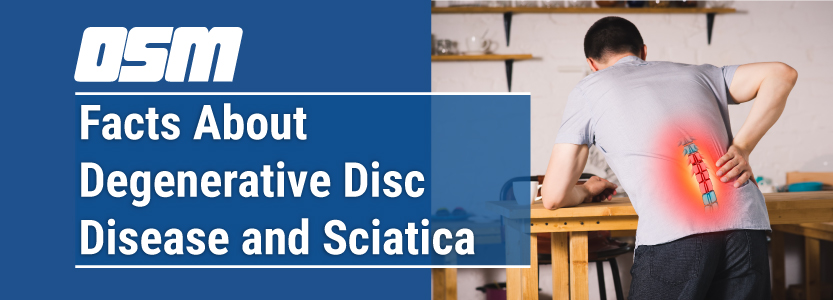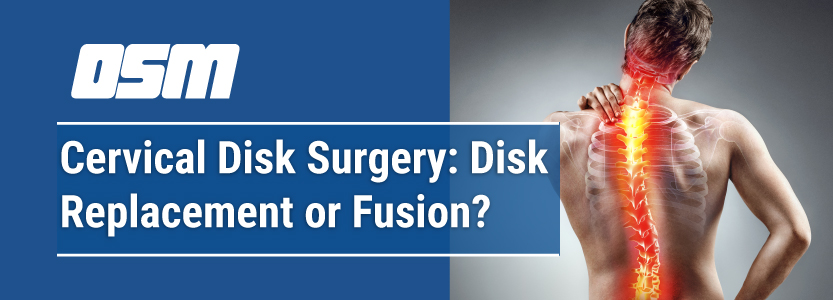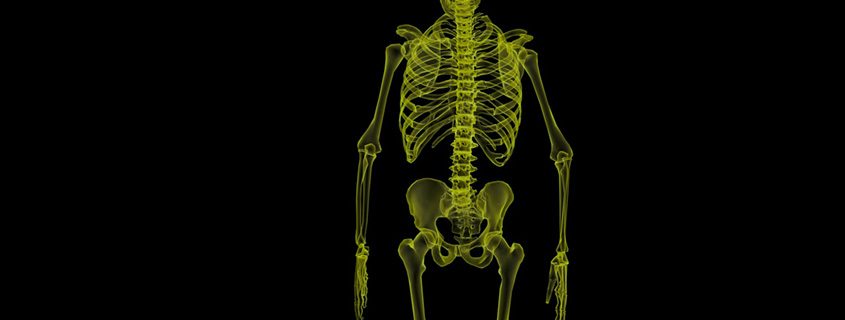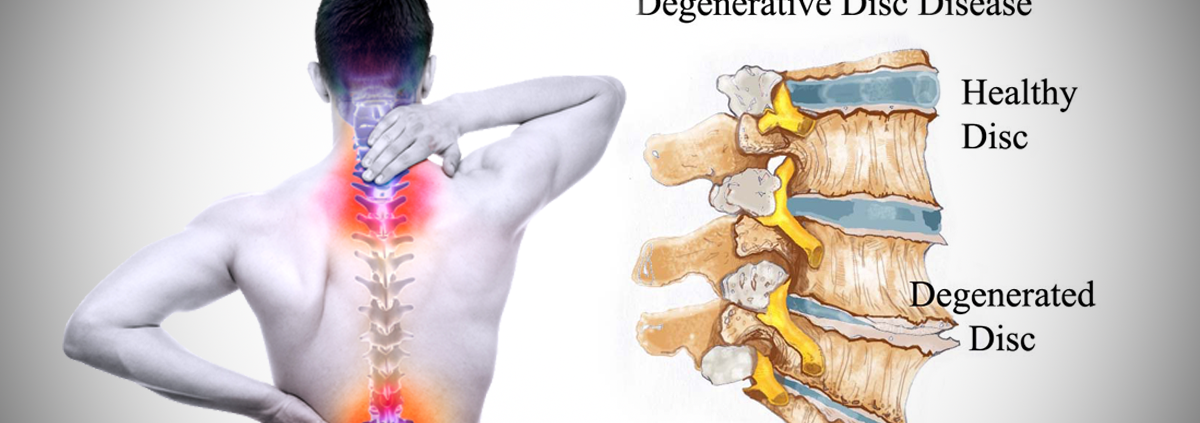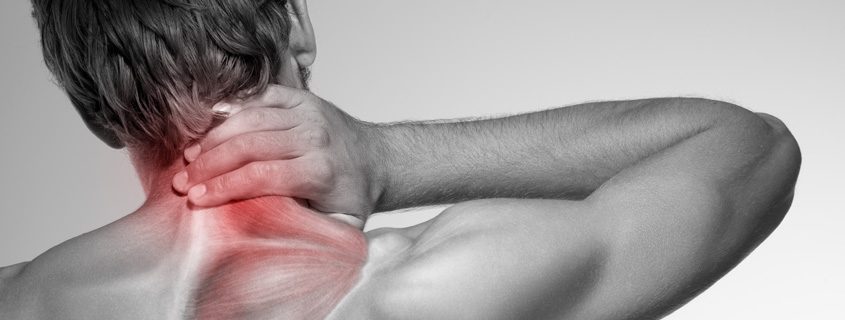Facts About Degenerative Disc Disease and Sciatica
Article featured on MedicineNet
Sciatica can result from lumbar disc herniation (“ruptured disc”) or spinal osteoarthritis when nerves in the low back are irritated by the abnormal anatomy in the low back.
What is the design of the spine?
The vertebrae are the bony building blocks of the spine. Between each of the largest part of the vertebrae are the discs. Ligaments are situated around the spine and discs. The spine has seven vertebrae in the neck (cervical vertebrae of the cervical spine), 12 vertebrae in the mid-back (thoracic vertebrae of the thoracic spine), and five vertebrae in the low back (lumbar vertebrae of the lumbar spine). In addition, in the mid-buttock beneath the fifth lumbar vertebra are five sacral vertebrae — usually fused as the sacrum bone followed by the tailbone (coccyx).
What is the purpose of the spine and its discs?
The bony spine is designed so that vertebrae “stacked” together can provide a movable support structure. The spine also protects the spinal cord (nervous tissue that extends down the spinal column from the brain) from injury. Each vertebra has a bony arch behind the spinal cord that shields the cord’s nerve tissue. The vertebrae also have a strong bony “body” in front of the spinal cord to provide a platform suitable for weight-bearing.
The spinal discs are pads that serve as cushions between each vertebral body that serve to minimize the impact of movement on the spinal column. Because the discs are situated between vertebrae, they are sometimes referred to as intervertebral discs. Each disc is designed like a jelly donut with a central softer component (nucleus pulposus) surrounded by a firmer ring of tissue (annulus fibrosus). With injury or degeneration, this softer component can sometimes rupture (herniate) through the surrounding outer ring (annulus fibrosus) and irritate adjacent nervous tissue. Ligaments are strong fibrous soft tissues that firmly attach bones to bones. Ligaments attach each of the vertebrae and surround each of the discs. When ligaments are injured as the disc degenerates, localized pain in the area affected can result.
Degenerative Disc Disease Symptom
Low Back Pain
Pain in the low back can be a result of conditions affecting the bony lumbar spine, discs between the vertebrae, ligaments around the spine and discs, spinal cord and nerves, muscles of the low back, internal organs of the pelvis and abdomen, and the skin covering the lumbar area.
What is degenerative disc disease? What causes degenerative disc disease?
As we age, the water and protein content of the cartilage of the body changes. This change results in weaker, more fragile, and thin cartilage. Because both the discs and the joints that stack the vertebrae (facet joints) are partly composed of cartilage, these areas are subject to wear and tear over time (degenerative changes). The gradual deterioration of the disc between the vertebrae is referred to as degenerative disc disease, sometimes abbreviated DDD. Wear of the facet cartilage and the bony changes of the adjacent joint is referred to as degenerative facet joint disease or osteoarthritis of the spine. Trauma injury to the spine can also lead to degenerative disc disease.
Degeneration of the disc space and its contents is medically referred to as spondylosis. Spondylosis can be noted on X-ray tests or MRI scanning of the spine as a narrowing of the normal “disc space” between the adjacent vertebrae.
What are degenerative disc disease symptoms?
Degeneration of the disc tissue makes the disc more susceptible to herniation. Degenerative spondylosis is another name for degeneration of disc tissue. Degeneration of the disc can cause local pain in the affected area. Any level of the spine can be affected by disc degeneration. When disc degeneration affects the spine of the neck, it is referred to as cervical disc disease. When the mid-back is affected, the condition is referred to as thoracic disc disease. Disc degeneration that affects the lumbar spine can cause low back pain (referred to as lumbago) or irritation of a spinal nerve to cause pain radiating down the leg (sciatica). Lumbago causes pain localized to the low back and is common in older people. Degenerative arthritis (osteoarthritis) of the facet joints that can be detected with plain X-ray testing is also a cause of localized lumbar pain. The pain from degenerative disc or joint disease of the spine is usually treated conservatively with intermittent heat, rest, rehabilitative exercises, and medications to relieve pain, muscle spasm, and inflammation.
What are the symptoms of radiculopathy and sciatica?
Radiculopathy refers to nerve irritation caused by damage to the disc between the vertebrae. This occurs because of degeneration (“wear and tear”) of the outer ring of the disc or because of traumatic injury, or both. Weakness of the outer ring leads to disc bulging and disc herniation. As a result, the central softer portion of the disc can rupture through the outer ring of the disc and abut the spinal cord or its nerves as they exit the bony spinal column.
It is important to note that many people have degenerative spines without having any symptoms. When nerves are irritated in the neck from degenerative disc disease, the condition is referred to as cervical radiculopathy. This can lead to painful burning or tingling sensations in the arms. When nerves are irritated in the low back from degenerative disc disease, the condition is called lumbar radiculopathy, and it often causes the commonly recognized “sciatica” pain that shoots down a lower extremity. This condition can be preceded by a localized low-back aching. Sciatica pain can follow a “popping” sensation at onset and be accompanied by numbness and tingling. The pain commonly increases with movements at the waist and can increase with coughing or sneezing. In more severe instances, lumbar radiculopathy can be accompanied by incontinence of the bladder and/or bowels.
How do health care professionals diagnose degenerative disc disease, radiculopathy, and sciatica?
Degenerative disc disease, radiculopathy, and sciatica are suspected when the symptoms described above are noted. The doctor can sometimes detect signs of irritated nerves during the examination. For example, increased radiating pain when the lower extremity is lifted supports the diagnosis of lumbar radiculopathy. Nerve testing (EMG/electromyogram and NCV/nerve conduction velocity) of the lower extremities can be used to detect the nerve irritation. Health care professionals can visualize degenerative spondylosis using plain film X-ray imaging of the spine, CAT, or MRI scanning. The actual disc herniation can be detected with radiology testing, such as CAT or MRI scanning.
What is the treatment for degenerative disc disease, radiculopathy, and sciatica?
The treatment of degenerative disc disease, radiculopathy, and sciatica ranges from nonsurgical (medical) management to surgery. Medical management of radiculopathy includes patient education of the condition, medications to relieve pain (NSAIDs, analgesics) and muscles spasm (muscle relaxants), cortisone injection around the spinal cord (epidural injection), physical therapy (heat, exercises, massage, ultrasound, electrical stimulation), chiropractic manipulation and rest (not strict bed rest, but avoiding reinjury). With unrelenting pain, severe impairment of function, or incontinence (which can indicate spinal cord irritation), surgery may be necessary. The operation performed depends on the overall status of the spine and the age and health of the patient. Procedures include removal of the herniated disc with laminotomy (producing a small hole in the bone of the spine surrounding the spinal cord), laminectomy (removal of the bony wall adjacent to the nerve tissues), by needle technique through the skin (percutaneous discectomy), disc-dissolving procedures (chemonucleolysis), and others.
What is bony encroachment and spinal stenosis?
Any condition that results in movement or growth of the bony vertebrae of the spine can limit the space (encroachment) for the adjacent spinal cord and nerves. Causes of bony encroachment of the spinal nerves include foramen narrowing (narrowing of the portal through which the spinal nerve passes from the spinal column, out of the spinal canal to the body), spondylolisthesis (slipping of one vertebra relative to another), and spinal stenosis (narrowing of the spinal canal causing by compression of the nerve roots or spinal cord by bony spurs or other soft tissues in the spinal canal). For example, lumbar spinal nerve compression in these conditions can lead to sciatica pain that radiates down the lower extremities.
Spinal stenosis (narrowing of the spinal canal) can occur at any level of the spine, but it’s most common in the lumbar spine of the low back. Symptoms depend on the level affected. For example, lumbar spinal stenosis can cause lower-extremity pains that worsen with walking and are relieved by resting (mimicking poor circulation of the lower extremities).
Treatment of these conditions varies (depending on the severity and condition of the patient) from rest to epidural cortisone injection and surgical decompression by removing the bone that is compressing the nervous tissue.
What is the outlook (prognosis) of degenerative disc disease, radiculopathy, and sciatica?
The outlook of degenerative disc disease, radiculopathy, and sciatica depends on the severity of the condition, its precise cause, and the interventions used to treat the patient. When patients respond to conservative treatments, the result can be complete healing. Surgical repairs can require postoperative rehabilitation, including physical therapy.
Is it possible to prevent degenerative disc disease, radiculopathy, and sciatica?
Avoiding injury can prevent degenerative spondylosis and resulting nerve irritation. When the disease already exists, aggravation of existing symptoms can be avoided by limiting stressing or overusing the involved spine.
The Orthopedic & Sports Medicine Center of Oregon is an award-winning, board-certified orthopedic group located in downtown Portland Oregon. We utilize both surgical and nonsurgical means to treat musculoskeletal trauma, spine diseases, sports injuries, degenerative diseases, infections, tumors and congenital disorders.
Our mission is to return our patients back to pain-free mobility and full strength as quickly and painlessly as possible using both surgical and non-surgical orthopedic procedures.
Our expert physicians provide leading-edge, comprehensive care in the diagnosis and treatment of orthopedic conditions, including total joint replacement and sports medicine. We apply the latest state-of-the-art techniques in order to return our patients to their active lifestyle.
If you’re looking for compassionate, expert orthopedic surgeons in Portland Oregon, contact OSM today.
Phone:
503-224-8399
Address
17355 Lower Boones Ferry Rd Suite 100A
Lake Oswego, OR 97035
Hours
Monday–Friday
8:00am – 4:30pm

